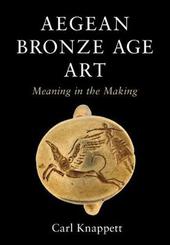
|
Aegean Bronze Age Art: Meaning in the Making
Hardback
Main Details
| Title |
Aegean Bronze Age Art: Meaning in the Making
|
| Authors and Contributors |
By (author) Carl Knappett
|
| Physical Properties |
| Format:Hardback | | Pages:350 | | Dimensions(mm): Height 260,Width 185 |
|
| Category/Genre | Ancient and classical art BCE to c 500 CE
Classical Greek and Roman archaeology |
|---|
| ISBN/Barcode |
9781108429436
|
| Classifications | Dewey:709.0130916388 |
|---|
| Audience | | Professional & Vocational | | Postgraduate, Research & Scholarly | |
|---|
| Illustrations |
Worked examples or Exercises; 1 Maps; 88 Halftones, black and white; 1 Line drawings, black and white
|
|
Publishing Details |
| Publisher |
Cambridge University Press
|
| Imprint |
Cambridge University Press
|
| Publication Date |
25 June 2020 |
| Publication Country |
United Kingdom
|
Description
How do we interpret ancient art created before written texts? Scholars usually put ancient art into conversation with ancient texts in order to interpret its meaning. But for earlier periods without texts, such as in the Bronze Age Aegean, this method is redundant. Using cutting-edge theory from art history, archaeology, and anthropology, Carl Knappett offers a new approach to this problem by identifying distinct actions - such as modelling, combining, and imprinting - whereby meaning is scaffolded through the materials themselves. By showing how these actions work in the context of specific bodies of material, Knappett brings to life the fascinating art of Minoan Crete and surrounding areas in novel ways. With a special focus on how creativity manifests itself in these processes, he makes an argument for not just how creativity emerges through specific material engagements but also why creativity might be especially valued at particular moments.
Author Biography
Carl Knappett is the Walter Graham/ Homer Thompson Chair in Aegean Prehistory at the University of Toronto. He is author and editor of An Archaeology of Interaction (2011), Network Analysis in Archaeology (2013), and Thinking Through Material Culture (2005). Since 2011 he directs an archaeological fieldwork project at the Bronze Age site of Palaikastro in east Crete.
|